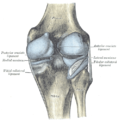Popliteus muscle
| Popliteus muscle | |
|---|---|
 Muscles of the back of the leg. Deep layer. (Popliteus visible at center top.) | |
| Details | |
| Origin | posterior-medial tibia under the tibial condyles |
| Insertion | middle facet of the lateral surface of the lateral femoral condyle |
| Artery | popliteal artery |
| Nerve | tibial nerve |
| Actions | Lateral rotation of femur and flexion of knee |
| Identifiers | |
| Latin | musculus popliteus |
| TA98 | A04.7.02.050 |
| TA2 | 2665 |
| FMA | 22590 |
| Anatomical terms of muscle | |
The popliteus muscle in the leg is used to unlock the knee during walking/running by laterally rotating the femur on the tibia (or medially rotating the tibia) during a closed chain movement (such as one with the foot in contact with the ground).
Origin and insertion
It originates from lateral surface of lateral condyle of femur, origin is intracapsular outer margin of lateral meniscus of knee joint. Insertion-posterior surface of shaft of tibia above soleal line.
Innervation
Nerve supply is via the tibial nerve from spinal roots L5 and S1.
Action
The Popliteus assists in flexing the leg upon the thigh; when the leg is flexed, it will rotate the tibia inward.
It is especially called into action at the beginning of the act of bending the knee, in as much as it produces the slight inward rotation of the tibia, which is essential in the early stage of this movement.
When the knee is in full extension; the femur slightly medially rotates on the tibia to lock the knee joint in place. Popliteus is often referred to as the "Key" to unlocking the knee since it begins knee flexion by laterally rotating the femur on the tibia.
Popliteus is also attached to the lateral meniscus in the knee; and draws it posteriorly during knee flexion to prevent crushing the meniscus between the tibia/femur as the knee flexes.
Variations
Additional head from the sesamoid bone in the outer head of the Gastrocnemius.
Popliteus minor, rare, origin from femur on the inner side of the Plantaris, insertion into the posterior ligament of the knee-joint.
Peroneotibialis, 14% of population. Origin is inner side of the head of the fibula, insertion into the upper end of the oblique line of the tibia, it lies beneath the Popliteus[1].
Trigger points
A popliteus shortened by trigger points can cause pain near its tendinous origin at the lateral knee.
Additional images
-
Right femur. Posterior surface.
-
Bones of the right leg. Posterior surface.
-
Capsule of right knee-joint (distended). Posterior aspect.
-
The popliteal, posterior tibial, and peroneal arteries.
See Also
References
External links
- Template:MuscleLoyola
- . GPnotebook https://www.gpnotebook.co.uk/simplepage.cfm?ID=93978702.
{{cite web}}: Missing or empty|title=(help) - Anatomy photo:15:st-0413 at the SUNY Downstate Medical Center
- Template:EMedicineDictionary
- PTCentral
![]() This article incorporates text in the public domain from page 484 of the 20th edition of Gray's Anatomy (1918)
This article incorporates text in the public domain from page 484 of the 20th edition of Gray's Anatomy (1918)

